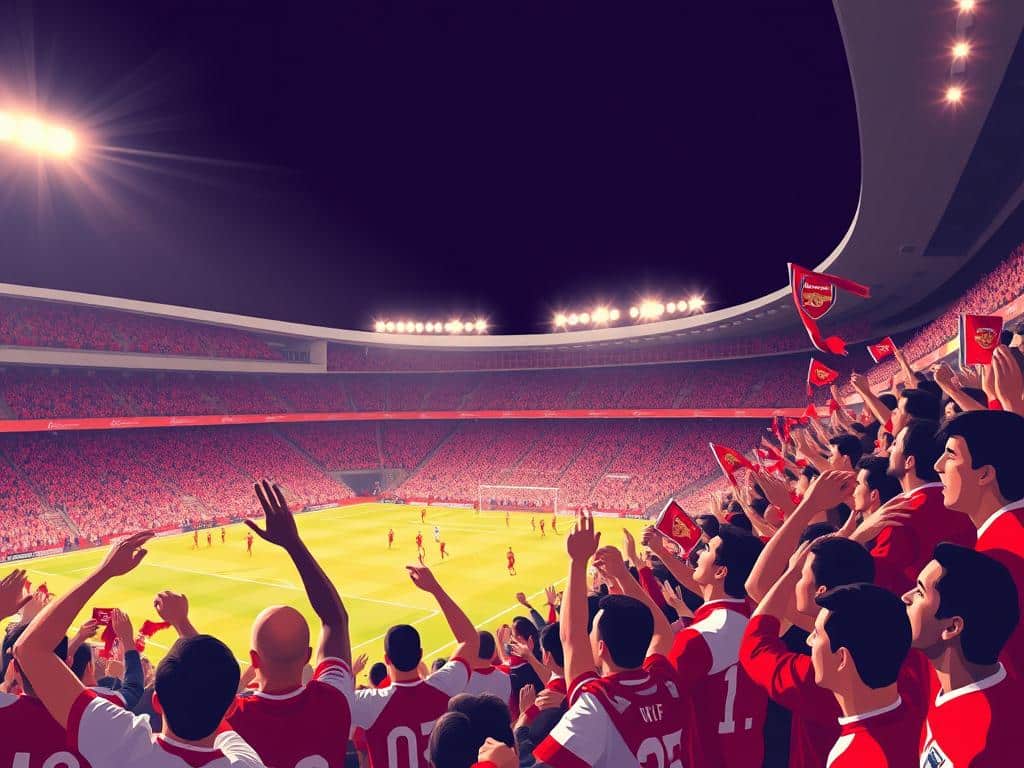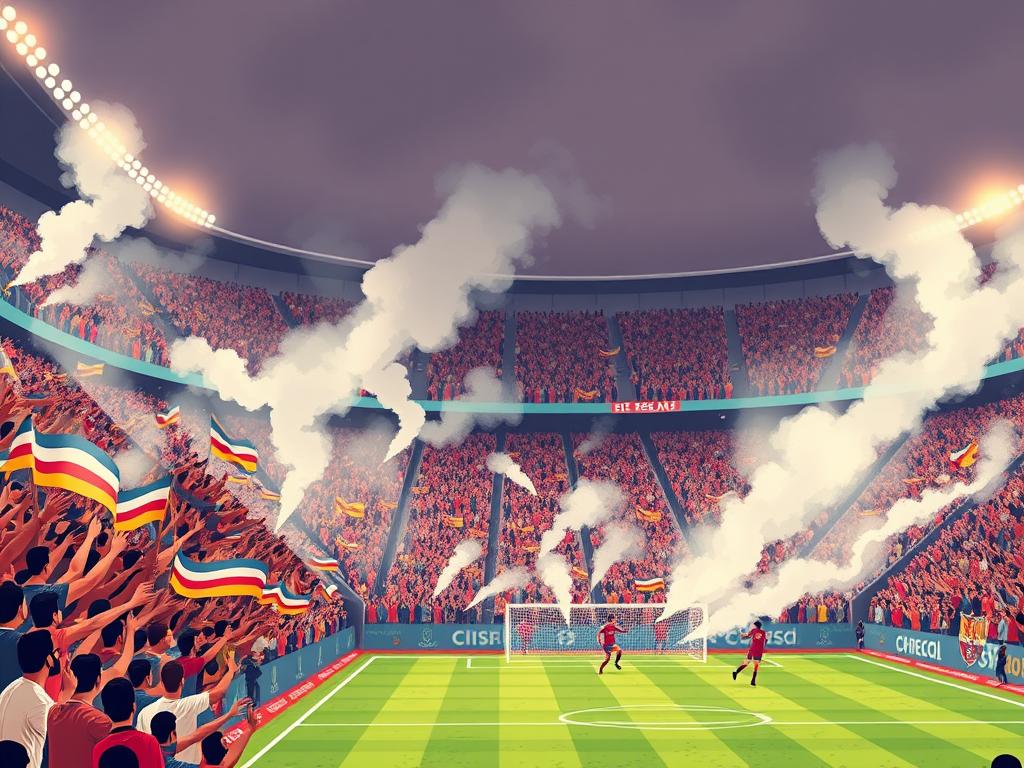I still get goosebumps when a stadium breaks into a familiar tune; it can change the mood of a match in an instant. Best soccer chants around the world are the heartbeat of matchday, mixing humor, pride, and a bit of menace that fans love.
I’ll show how a popular song on the radio can become a terrace staple and why simple lyrics often stick longer than clever ones. You’ll meet anthems born in pubs, cup runs, and radio hits—like Liverpool’s spine-tingling hymn, Man United’s Glory cry, and newer player songs that spread overnight.
Expect clear examples: the tune, the moment it caught fire, and the stand where it hits hardest. By focusing on real matchday impact, I’ll explain why these football chants still give goosebumps every time and how they shape club identity.
Key Takeaways
- Chants link a tune, moment, and crowd to create lasting anthems.
- Simple, repetitive lyrics help tens of thousands sing in sync.
- Many anthems started as popular song covers or barroom tunes.
- Football chants can intimidate opponents, boost players, or unite fans.
- I will point to exact lyrics, stands, and moments that made chants famous.
What makes a chant unforgettable on the terraces
Great terrace songs grab you by the first line and carry thousands in one voice. I break down four core traits that turn simple lines into lasting anthems.
Memorability
Short, repeatable lyrics and a familiar tune let a crowd join by the second line. Think two-line hooks that any fan can sing from the back row.
Longevity
Supporters keep a chant alive when it reflects club history. If words fit a story, generations pass them on—like a melody that becomes identity.
Functionality
Simple beats and clear rhythm win. A whole end should clap it and stay in sync; that makes it useful during match noise and rain.
Intimidation
When thousands roar a chorus, opposition fans feel it. A well-timed howl after a tackle can change momentum and unsettle visiting supporters.
| Factor | What to aim for | Example | How to test it |
|---|---|---|---|
| Memorability | Short hook + familiar tune | “Blue Moon”-style lines | Sing from the seats; does it stick? |
| Longevity | Roots in club story | “I’m Forever Blowing Bubbles” | Do older fans know the words? |
| Functionality | Clap-ready beat | Simple call-and-response | Can the end keep time? |
| Intimidation | Volume + timing | “Glory, Glory” eruptions | Do opposition fans quieten? |
You’ll Never Walk Alone: Liverpool and Celtic’s iconic chant
Few pre-match moments match the hush that falls when thousands lift scarves and begin a single, soaring chorus. I watch that lift at Anfield and Parkhead and feel how a line of song becomes a living promise.
How a 1960s tune became a club ritual
In 1963 Bill Shankly embraced the Rodgers and Hammerstein number from Carousel and Liverpool made the song their walkout anthem. The Kop turned it into identity; simple words and a soaring tune made it easy for every fan to join.
The Hillsborough tragedy gave those lyrics deeper weight. What began as pre-match ritual became collective remembrance and strength. Celtic adopted the same chorus before big European nights, proving the line travels and still unites.
Quick facts
- Liverpool made it identity in the 1960s under Shankly.
- The chorus — “Walk on, with hope in your heart… you’ll never walk alone” — is sung before every home kickoff.
- After Hillsborough the line turned into public memory and solidarity.
- Celtic’s Parkhead often rises with the same anthem before European ties.
- Its simple structure helps away ends claim space and fans of all ages join in.
| Feature | Liverpool | Celtic |
|---|---|---|
| Adoption | 1963, promoted by Shankly | Longstanding use, often for European nights |
| Role | Club walkout anthem and remembrance | Unity and European atmosphere |
| Impact | Unites home and away supporters | Rallies supporters across generations |
Blue Moon: Manchester City’s timeless anthem
On Etihad nights a simple melody can swell until every voice is part of a single heartbeat.
Blue Moon was written in 1934 and found new life in sky blue. City fans carry the chorus a cappella, stretching notes as the team presses for a goal.
- A 1930s popular song reborn for a modern club—this tune became matchday heartbeat.
- The chorus—“Blue Moon, you saw me standing alone…”—turns lyrics about solitude into belonging.
- The melody is simple, so the entire end stays in step, even without the PA.
You’ll hear it before kick-off at the Etihad, and again after a statement win. Away supporters also use it to stamp identity in tight allocations.
| Feature | What to listen for | Match moment |
|---|---|---|
| Tune | Long, held notes on the chorus | When City attack late |
| Lyrics | Simple, repeatable line | Pre-match and post-win |
| Impact | Unites fans and players | Signals club identity in the Premier League era |
Practical tip: if you hear a lone voice start the line, join in—newcomers hum it after one game and it embeds fast. Over time that calm melody and modern success made Blue Moon City’s clearest audio signature.
Glory, Glory Man United: a Stretford End standard at Old Trafford
When the Stretford End starts a marching line, you feel the stadium lean in. I can still picture Wembley in 1983, when that chorus first echoed after the FA Cup win over Brighton.
Born on a Wembley stage in 1983, the song anchored Man United identity. It moved from one big night to every big night at Old Trafford.
The Stretford End sets the rhythm. Once it begins there, united fans around the ground lock on and follow.
- Simple chorus and marching cadence help supporters sustain it through long spells.
- Rival retorts—like the famous shout-back—only fuel louder replies and edge the atmosphere.
- It links eras: from Sir Alex Ferguson’s dominance to modern squads, the lines carry belief.
- Lyrics are clean, direct, and built for celebratory breaks after goals or late pushes.
- Paired with flags and scarves, the stand becomes a moving wall of sound.
| Origin | Role | Impact |
|---|---|---|
| 1983 FA Cup final, Wembley | Stretford End initiator; club anthem | Unites fans; triggers stadium-wide responses |
| Marching cadence | Easy to learn and sustain | Audible push in stoppage time; boosts momentum |
| Rival interaction | Back-and-forth with visiting supporters | Raises volume and adds competitive edge |
I’m Forever Blowing Bubbles: West Ham United under the lights
Under floodlights at London Stadium, a single chorus can make time feel suspended.
I grew up hearing that music-hall line turned into ritual. Adopted by West Ham in the 1930s, this song is sung before every home game. The chorus—“I’m forever blowing bubbles… they fly so high…”—still lands like a promise.
The bubbles drifting above the pitch give a rare visual to match a tune. Fans throw them into the air and the sight pairs with the melody. It turns a routine kickoff into a shared memory.
- West Ham made a music-hall or popular song their club ritual, lasting nearly a century.
- The bittersweet lyrics feel like hope and loss sung at once.
- Under the lights the slow rise and fall of the tune carries through the bowl.
| Feature | Why it matters | Match impact |
|---|---|---|
| Origin | 1930s music-hall / popular song | Links past venues to modern home |
| Visual | Bubbles over the pitch | Creates a unique pre-match atmosphere |
| Singability | Simple melody and clear lyrics | New fans join on first listen |
| Recognition | Long-standing identity | One of the premier league pre-match moments |
It’s Coming Home: England’s tournament refrain
When thousands chant one short phrase, you hear history and hope in equal measure.
I remember 1996 and how “Three Lions” turned a pop tune into a national cry. Coming home began as a lyric about past failures — “thirty years of hurt” — and became a flexible rallying line for every deep run since.

England fans revive the chorus in streets, fan zones, and stadia. It shifts tone: a quiet, steady song before kickoff, then a shouted cry after a goal. Players often mention it in interviews; when a squad leans in, the volume rises and belief spreads.
- Born from “Three Lions” (1996), the phrase is now a national team marker.
- The simple lyrics let casual supporters join quickly.
- It steadies nerves during penalties and celebrates big moments abroad.
| Feature | Why it works | Match moment |
|---|---|---|
| Short hook | Easy to learn | Pre-kickoff and goals |
| Nostalgic line | Turns hurt into humor and hope | Deep tournament runs |
| Portable | Travels with fans | Away allocations and fan zones |
Flower of Scotland: the Tartan Army’s national team chorus
When bagpipes lift a simple refrain, Hampden fills with a hush that feels almost sacred. I watch as a lone piper sets the pulse, then fans answer in a tide of sound.
Flower of Scotland is more than a song at matches; it reads like history. The lyrics recall resistance to Proud Edward’s army, so every line carries weight beyond sport.
The pacing of the tune lets crowds link arms and sing in full voice. At Hampden, reverb doubles the impact and turns a phrase into a surge.
- A proud pre-match ceremony: bagpipes swell, then the Tartan Army takes the chorus.
- Away days keep the refrain going mid-game, often after big tackles.
- Simple, declarative lines make it easy for every voice to join.
| Origin | Match Moment | Impact |
|---|---|---|
| Scottish folk song | Pre-match and key moments | Unity, pride, rising adrenaline |
| Bagpipe-backed start | Hampden Park’s kickoff | Acoustic power, intimidates opponents |
Players often say the chorus lifts them before kickoff. In tight qualifiers, its gravitas helps settle nerves and sharpen focus on the football pitch.
Don’t Take Me Home: Wales and England’s away-day soundtrack
A tiny hook sung loud will make strangers feel like teammates for a few hours. I first heard this refrain at Euro 2016 when Wales turned a pub singalong into tournament folklore.
Don’t Take Me Home is a pure away-day anthem. Its simple lyrics say what everyone feels: skip the commute, keep celebrating. Wales owned it, and england fans picked it up fast.
The tune needs no instruments. That makes it perfect for echoey fan zones, trains, and extra-time marathons. It steadies voices and builds a crowd swell—especially on the line “Please don’t,” which gives a natural crescendo.
- Born at euro 2016 with Wales; spread quickly.
- Works anywhere: plazas, upper tiers, or on a sleeper train.
- Opponents hear it and know these supporters mean to stay loud.
| Origin | Function | Match use |
|---|---|---|
| Euro 2016 | Unifying away anthem | Extra time, post-match plazas |
| Wales | Catchy, easy to loop | Traveling supporters and fan zones |
| Adopted by others | Signals celebration | Football trips and long nights |
Allez, Allez, Allez: from Europe to Premier League fever
A drumline and a simple hook can turn a quiet stand into a rolling wall of sound. That is exactly what happened when “Allez, Allez, Allez” left terraces and filled city centers.
Liverpool popularized this during the 2017/18 Champions League run. Jamie Webster’s recorded song helped it spread fast. You can hear the drum-led build in tunnels and away ends, where echo and anticipation make it thunder.
Liverpool’s European nights and the chant’s drum-led build
On big nights, liverpool fans start with two claps, then the drum lifts the tune. The short chorus and tight beat let thousands join in seconds. Flares, scarves, and that drop create a continental feel on home soil.
Arsenal’s version at the Emirates
Arsenal adapted the same bones into a club-specific version. arsenal fans use it after statement wins—same rhythm, different lyrics. The flexibility keeps it fresh while core rhythm stays familiar.
- Short lines, big chorus: easy claps and quick join-in.
- Travels well: from squares to stadium tunnels with flares and drums.
- Contemporary feel: premier league nights can sound truly continental when it breaks out.
| Feature | Liverpool | Arsenal |
|---|---|---|
| Origin boost | 2017/18 run + Jamie Webster | Club-adapted after big wins |
| Performance | Drum-led, tunnel echo | Stadium drop, celebratory use |
| Lyric use | Honours past and present (lyrics) | Club-specific lines and calls |
| Impact | City fans sing in sync across Europe | Rallies home end after big results |
Que Sera, Sera: the universal Wembley daydream
When Wembley looms, a familiar line can make every singing fan feel they share the same map. I hear it most after a semi or when a playoff finishes in your favor.
Adapted from Doris Day’s 1955 hit, this simple song has become Britain’s go-to singalong for big cup days. The melody is smooth and friendly, offering a calm interlude amid louder, aggressive calls.
- Wembley on the horizon? It is the automatic soundtrack in many stands, signaling celebration and relief.
- Because the lyrics rarely change, supporters anywhere can jump in instantly and feel part of the crowd.
- Best used right after a semi win or playoff clincher—its warmth fits triumph rather than taunt.
- The word home flips meaning here: Wembley becomes every club’s destination and shared promise.
- It suits minnows and giants alike; the same tune carries a small club’s dream and a major team’s bid.
- Generations connect: grandparents hum lines while young fans add their voices, so ritual continues.
| Feature | Match use | Impact |
|---|---|---|
| Melody | Post-win, pre-celebration | Soothes and unites crowds |
| Lyrics | Stable across clubs | Instant singalong, wide join rate |
| Team reaction | Often acknowledged on pitch | Creates shared memory and build-up to finals |
Will Grigg’s on Fire: Northern Ireland’s Euro 2016 phenomenon
A single, cheeky hook can turn city squares into stadiums overnight. At Euro 2016 Northern Ireland fans hijacked Gala’s 90s dance tune “Freed From Desire” and made it into an unstoppable football chant.
I stood among fans as the chorus—“Will Grigg’s on fire, your defence is terrified”—echoed through fan zones. The lyrics were playful and taunting, perfect for an underdog crowd full of belief.
- Terrace masterclass: a club-style pop tune flipped into a matchday juggernaut.
- Nonstop street party: fans sang it across cities, not just in stadiums.
- Built for bouncing: the tune’s beat made whole stands move on the chorus.
- Adaptable: clubs re-skinned the line for other players within days.
- Meme fuel: simple lyrics and a famous name made it viral online.
| Feature | Why it worked | Example |
|---|---|---|
| Tune | Familiar dance riff, easy to loop | “Freed From Desire” backbone |
| Lyrics | Catchy, taunting, short | “Will Grigg’s on fire…” |
| Impact | Defined tournament soundscape | Euro 2016 streets and stadia |
Arsenal in full voice: from Kai Havertz to Riccardo Calafiori
At the Emirates a single line can light up an entire stand and change a quiet stretch into a roar. I felt that shift as new refrains moved through the stadium and out into travel crowds.

Kai Havertz to Waka Waka: a viral Emirates singalong
When fans began singing a Waka Waka version, it hit social feeds fast. The viral line — “£60 million down the drain, Kai Havertz scores again” — flipped a transfer jibe into celebration.
Why it caught on: it reused a familiar tune, kept lyrics short, and let the whole end join after one cycle.
Calafiori to That’s Amore: red over blue, a new fan favorite
Riccardo Calafiori’s line—“He chose red over blue… Calafiori”—fits That’s Amore and lands as playful banter. It’s clappable, melodic, and easy for casual attendees to learn.
- Arsenal fans began singing louder since 2022/23, building on Saliba’s “Tequila” and “North London Forever.”
- Short refrains let players hear their name and gain confidence.
- Global tune choices help newcomers join instantly.
| Feature | Kai Havertz (Waka Waka) | Calafiori (That’s Amore) |
|---|---|---|
| Origin | Viral social clip after a big goal | Playful jab after transfer; easy clap pattern |
| Lyric hook | Transfer jab turned celebration | Name woven into chorus |
| Match use | Late goals and post-win singalongs | Pre-match and during celebrations |
| Why it works | Familiar tune + spicy lyric | Simple rhythm + catchy name |
Manchester City’s Fleetwood Mac “Everywhere” run-in chant
Sometimes a simple pop chorus becomes a run-in ritual overnight.
I heard this one during City’s 2023 treble push and it stuck. To Fleetwood Mac’s “Everywhere” fans sung a revised chorus—“Can you hear me calling… We’re Man City…” that ends on “I wanna follow you everywhere.”
Why it worked: the upbeat tune matched quick, high-tempo football late in the season. The lyrics about following fit a club chasing trophies on all fronts. Some debate the chant’s origin, but manchester city popularized it as results piled up.
- city fans sing it with a bounce—an instant party starter in the run-in.
- The pop familiarity lets the whole end catch it on cue, home or away.
- It sits alongside Blue Moon: one ritual, one party line for post-match celebrations.
| Feature | Why it works | Match moment |
|---|---|---|
| Melody | Upbeat, easy to loop | Late-season run-ins and celebrations |
| Lyrics | Follow-you theme fits trophy chase | After goals and in concourses |
| Spread | Viral in 2023; echoed home and away | Fan zones and stadium entries |
Manchester United on the terraces: Bruno to the Stretford End and Amorim belief
At Old Trafford a single name can start a ripple that fills the whole bowl. I’ve seen a lone voice turn into a full-throated chorus in minutes.
Bruno Fernandes, the Portuguese Magnifico
Bruno, Bruno, Bruno… He’s our Portuguese Magnifico… is simple and direct. Those lyrics hang on a short hook, so any new attendee can join after one repeat.
Ruben Amorim, a new song for a new era
To the tune of “It’s a Heartache” fans sing: “Ruben Amorim, he’ll bring the glory days again… we’ll back him from the Stretford End.” It reads as a pledge more than a boast.
- The Stretford End sets the tone—when Bruno’s chorus hits, Old Trafford lifts.
- Manchester United fans began singing the Amorim line early in his tenure, a sign of trust.
- Call-and-response sections keep united fans engaged during lulls.
- Clear names in the chorus help newcomers latch on fast.
- Simple melodies ensure thousands can sustain the chant through hard spells.
| Feature | Bruno | Amorim |
|---|---|---|
| Hook | “Portuguese Magnifico” | “Bring the glory days again” |
| Function | Instant singalong; lifts players | Patience and backing from fans |
| Cultural fit | Stretford End rally | Continues Red Devils tradition |
Liverpool’s player songs: Virgil van Dijk and Luis Díaz
Sometimes a short name sung loud bridges pitch and stand like an instant handshake. I’ve watched two player anthems become part of Liverpool’s matchday sound—one calm and commanding, the other spicy and infectious.
Van Dijk to Dirty Old Town: calm as you like
He’s our center-half, he’s our number four… calm as you like rides the “Dirty Old Town” tune. The slow melody lets the crowd swell on “He’s Virgil van Dijk.” It fits his composed style and lands loud after a big block or header.
Luis Díaz to Bella Ciao: Barrancas to the Kop
His name is Luis, he’s from Barrancas… uses “Bella Ciao” for Latin flair. It lifts during counterattacks and feels playful. Name-driven lyrics give fans a direct link to the player and spark quick, mid-match bursts.
- Both are easy to clap with and repeat.
- Short lines survive noisy moments and boost momentum.
- They show how a club adapts global tunes into local identity.
| Feature | Van Dijk | Luis Díaz |
|---|---|---|
| Tune | “Dirty Old Town” — steady | “Bella Ciao” — upbeat, Latin |
| Focus | Defending, calm authority | Origin, flair, attack |
| Match use | After tackles, set pieces | After dribbles, goals, counters |
Old viral football chants that still get a laugh
A cheeky line dropped at the perfect beat will have strangers grinning in sync. I love these lighter moments: they show how wit, a known melody, and sharp timing turn an ordinary match hour into a running joke.
Scotland’s “Deep fry your pizzas” (to Guantanamera)
Humor travels: that pizza jibe riffs on “Guantanamera” and often surfaces when Scotland face Italy. The familiar tune gives space for short, pointed one-liners that land instantly.
“Come on David Moyes” (to Slade)
Glam-rock cheer: adapted from Slade’s “Cum on Feel the Noize,” this line showed early optimism at Manchester United. It’s simple, singable, and hooks attention after a half-chance or a substitution.
- Short jokes work best; fans repeat them for minutes without fading.
- Well-known tune and tight lyrics make punchlines audible across a bowl.
- Opposition fans sometimes volley back, turning it into playful theater.
- Timing matters—drop a line after a missed chance and the whole end roars.
- These refrains age well because melody keeps them fun even as context shifts.
How fans sing the best soccer chants around the world
A well-timed clap pattern can turn a quiet terrace into a pulsing sea of sound. I watch that signal start more than planned rehearsals. In Britain and beyond, a tackle, a save, or a breakaway sparks voices fast during a game.
Home and away: timing, tune, and the role of the supporters
I notice two kinds of outbreaks: coordinated leads and spontaneous bursts. At home, a drum or capo often starts a call. Away, fans favour looped refrains that survive long pressure spells.
- Capos aren’t always needed — fans sing when a moment ignites emotion.
- Familiar tune matters — simple melodies let terraces lock in fast.
- Visual cues help — raised scarves, conductor hands, or a leading voice set the pace.
- Concourses and clips — new refrains test in fan zones and spread via social video.
- Stamina wins — short lines with rests keep a chant alive through a full match.
| Place | Starter | Why it works |
|---|---|---|
| Home | Drum or capo | Launches mass join-in |
| Away | Looped refrain | Sustains under pressure |
| Fan zones | Small groups | Rapid spread via video |
Clubs that keep clear anthems set a tone pre-match, then revert to reactive bursts as the football action unfolds. That mix of plan and spontaneity is how a chant lives on.
Rivalry and response: when opposition fans sing back
When an away group fires back, a match can feel like a music duel as much as a football game. That volley changes a quiet phase into a charged exchange and raises stakes for every fan in the bowl.
How it works: one end starts a line and opposition fans answer, often with a sharper, taunting reply. Think of the retort to “Glory, Glory Man United” — a shouted “Who the f are Man United?” — which ramps volume and edge instantly.
- Rival games become musical duels; one side fires, the other volleys back.
- Call-and-response hones focus on the team and shifts momentum after a big moment.
- Simple taunts ride known tunes so both ends stay in rhythm and loud.
- United fans often answer louder after a rival dig; volume becomes a statement of strength.
- Timing is key: a return chant after a near-miss stings most and can rattle opponents.
| Effect | When it hits | Match outcome |
|---|---|---|
| Volume boost | After taunts or big chances | Psychological edge for home side |
| Momentum swing | Post-save or late tackle | Team lifts or tightens defensively |
| Televised drama | Rival fixtures | Match sounds feel electric at home |
Coaches and players notice this. When a crowd trades lines, it can lift a side up the pitch or unsettle an opponent. In heated fixtures, the soundtrack becomes part of how both teams are played.
Conclusion
Across clubs and tournaments, a single chorus can turn a short moment into a lasting memory.
I’ve shown how simple, singable lines tie past and present. From YNWA to Blue Moon, from the Stretford End to away fan zones, songs link players, team moments, and fans sing in one voice.
Keep it short, choose a familiar melody, and add a clear clap. That recipe helps a club line survive time and move from a one-off joke to living tradition.
Takeaway: whether in the Premier League or at a tournament, let history meet the present, let supporters lead, and let the chorus carry the game forward.







